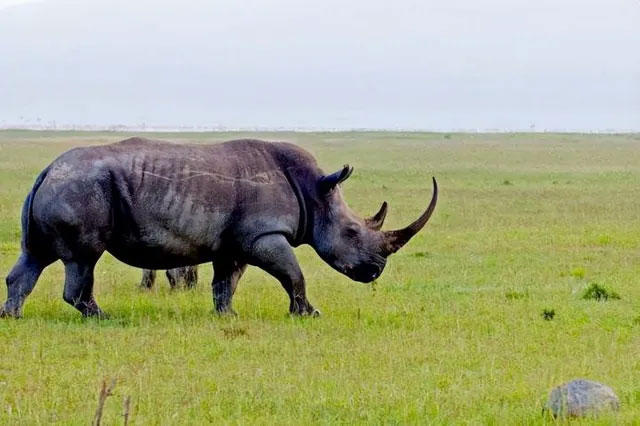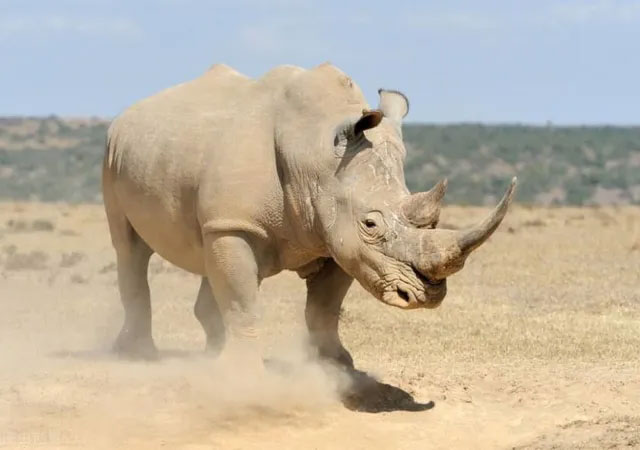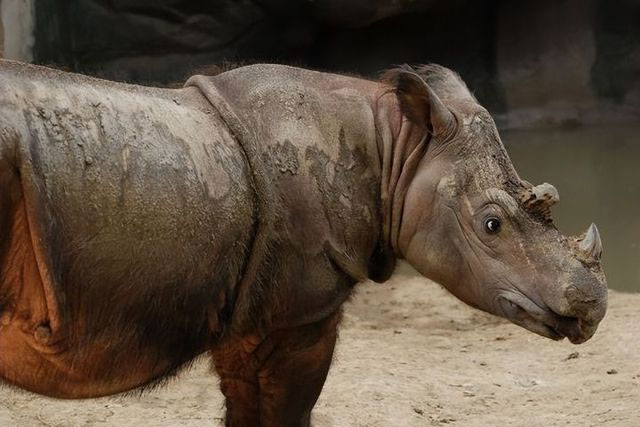Turns out China used to have more rhino species than Africa
It is believed that there are five species of rhino in the world: the black rhinoceros, the white rhinoceros, the Sumatran rhinoceros, the Javan rhinoceros and the Indian rhinoceros.
The first two types of rhinoceros are from Africa and belong to the species of two-horned rhinoceros. The wild black rhino mainly occurs in central Africa and the wild white rhino mainly occurs in southern Africa, but a large number of hybrids of the two species exist between the two ranges. of them. Among them, there are about 5,000 black rhinos in the world, the number of white rhinos currently exceeds 20,000, and the photo below is what a black rhino looks like.

Black rhino.
The black rhinoceros is an odd-toed ungulate mammal native to regions of eastern and central Africa including Kenya, Tanzania, Cameroon, South Africa, Namibia and Zimbabwe.
The species with the largest body of the 5 rhino species mentioned above is the white rhinoceros, with a maximum weight of 3.5 tons, similar to hippos, and second only to elephants among terrestrial animals. . The picture below is a white rhino.

White rhinoceros.
The white rhinoceros or square-lipped rhinoceros is one of only five extant rhino species and one of the very few extant large herbivores. They are native to northeastern and southern Africa. Rhinos tend to live in herds of two to seven, although they are large animals.
Sumatran rhinoceros, Javan rhinoceros and Indian rhinoceros are the last three types of rhinoceros that inhabit only Asia.

The Sumatran rhinoceros, also known as the two-horned rhinoceros, is the smallest extant rhino species, as well as one of the hairiest species. Like the African species, they have two horns. At one time they were widespread in Southeast Asia, but today there are only about 80 individuals left.
The Javan rhinoceros is mainly distributed on the Indonesian island of Java and the Indochinese peninsula, but today the animal only exists in Indonesia's Ujung Kulong National Park, and the population does not exceed 80 (the global ).

The Javan rhinoceros or Sunda rhino, also known as the one-horned rhinoceros, is one of the five extant species of ungulates in the Rhinoceros family.
The Indian rhinoceros is mainly distributed in places like India and Nepal, with about 3,200 individuals left in the world.

The Indian rhinoceros or large one-horned rhinoceros is a species of rhinoceros native to the Indian subcontinent. They are assessed as Vulnerable and included in the IUCN Red List, as populations are fragmented and limited to less than 20,000 square kilometers.
This also shows that there are actually more rhino species in Asia than there are in Africa. Of the three types of rhinoceros in Asia, the Sumatran rhino is a two-horned rhinoceros, while the Javan rhinoceros and Indian rhinoceros are both single-horned rhinos.
As mentioned earlier, wild rhinos existed in China more than 100 years ago, they usually inhabit the southwestern part of the country. In the more distant past, they even existed in the North China Plain and Northwest China.
The earliest rhino fossils unearthed in China show that the existence of rhinos in this country can be traced back to 20 million years ago, and their range is very wide. In the history of civilization of ancient China, rhinoceros has never been absent from ancient books and ancient texts, there are documents showing that at least in the Warring States period rhino skin was used to make armor and Previously, rhino horn was also used to make drinking glasses and medicinal herbs (modern science has proven that rhino horn is similar to human fingernails, and has no value in medical applications). .

Fossils show that the existence of rhinos in China can be traced back to 20 million years ago.
An ancient record also verifies that in the Shang dynasties and before that, the northernmost boundary of the Chinese rhinoceros could have been around Inner Mongolia and Wuhai, during the Zhou dynasty the boundary was further south to Qinghai and southeastern Gansu, southern Shaanxi, Han River basin and Huai River basin to the lower Yangtze River.
After the Han Dynasty, the distribution of rhinos in China quickly moved south, by the Tang Dynasty, they were mainly distributed from Tay Ninh, Qinghai to Zhangzhou, Fujian. After the Tang Dynasty, the rhino species here were only south of the Yangtze River, and during the Song Dynasty were Guangdong, Guangxi, Yunnan and Tibet. During the Ming and Qing dynasties, rhino species existed only in Yunnan and Guangxi. And now they are completely extinct in this country.
The Indian rhinoceros in China became extinct in 1920, just 102 years ago; Sumatran rhinoceros went extinct in 1916, 106 years ago; The Indo-Chinese subspecies Javan rhinoceros became extinct in 1855, 167 years ago, and the Indian Javan rhinoceros subspecies went extinct in 1922, that is, 100 years ago.


The main cause of rhinoceros extinction is human hunting.
So why are these three rhino species in China gradually becoming extinct? The first cause is climate change throughout the history of the Earth. The cold climate is an important cause, rhinos have less hair, their bodies are very cold, and colder climates will cause rhinos to have less food. Therefore, the living area of China's rhinoceros is also gradually moving south to better suit living conditions.
However, the most important reason and also the direct reason for the extinction of rhinos in this country is due to human hunting, as mentioned above, rhino skin can be used as armor. Rhino horns can be used to make wine glasses, ingredients for medicine, and of course other parts of the rhinoceros are also used, so it can be said that this is a very attractive animal for some people.
- Rhino protection campaign
- The faint future of Java rhino
- Save the rhino's synthetic rhino horn
- South Africa protects rhinos with reconnaissance aircraft
- South Africa combats rhino poaching with chips and DNA
- Rhinos are killed more and more
- Mother died, the rhinoceros child refused to sleep alone
- VN-South Africa is about to sign the MoU to prevent rhino horn trade
- South Africa poisoned rhino horn
- Rare rhinos in East Africa give birth
- Rhinoceros risking their lives with elephants to protect them
- More than 400 individual rhinos were killed
 Animal 'suffering' after hibernation
Animal 'suffering' after hibernation Why do goats climb well?
Why do goats climb well? Scientists were surprised to see chimpanzees eating turtles
Scientists were surprised to see chimpanzees eating turtles Giant catfish died deadly due to drought in Thailand
Giant catfish died deadly due to drought in Thailand 32,400-year-old rhino mummy found with intact skin and fur
32,400-year-old rhino mummy found with intact skin and fur  The rarest animal on the planet, there are only 2 individuals left in the world
The rarest animal on the planet, there are only 2 individuals left in the world  China's thousand-year-old national treasure originating from Vietnam: Extremely rare item!
China's thousand-year-old national treasure originating from Vietnam: Extremely rare item!  Signals for rhinos a rare horn in Vietnam
Signals for rhinos a rare horn in Vietnam  The most endangered rhinoceros
The most endangered rhinoceros 